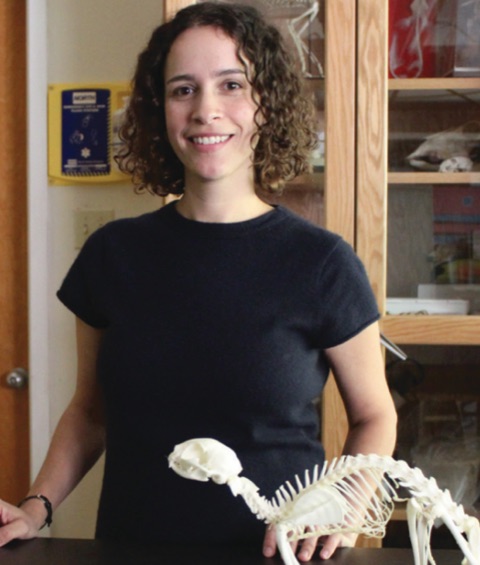Jaime Tanner on Form and Function in Nature and Dogs on the Common

Associate Professor Jaime Tanner joined the Marlboro Institute for Liberal Arts and Interdisciplinary Studies this fall from Marlboro College, where she taught biology and environmental studies for 10 years.
Tanner graduated from the University of Massachusetts, and holds a PhD from Michigan State University. From 2008-2010, she was a Darwin Post-Doctoral Fellow at UMass. Much of her research has focused on the relationship between form and function in the anatomy, particularly skulls, of spotted hyenas.
This conversation, conducted early in the spring semester, has been edited for length and flow.
ET: Why hyenas?
JT: Hyenas are really fascinating animals. They’re really unusual in a lot of ways, in terms of behavior and anatomy. Once people start hearing about them they get really hooked.
When I was 8 years old, I read an article about Dian Fossey, who worked with mountain gorillas, and I came home and told my mother I was going to study animals in Africa when I grew up. My junior year, I went to Kenya for study abroad, and while there I traveled to the Masai Mara Game Reserve. We had a guest lecture from a hyena researcher telling us about how bizarre hyenas are … about their social structure and hunting abilities. I saw a hyena kill and eat a Thomson’s gazelle within 10 minutes, and I was just kind of hooked.
….
In general, my research involves looking at the relationships between form and function, in particular in skulls. Spotted hyenas have incredible jaw strength, they can crack open giraffe legs. Another piece is hyenas have female dominance. Females are larger and more socially aggressive.
I was looking at the development of these bone-cracking jaws and it actually takes a really long time for hyenas to develop bone-cracking ability. That means the young are at a disadvantage for feeding, especially in such a social species. So having these big, strong moms who can secure food for the kids [is necessary]. It’s a combination of, they’re a social species, there’s competition, and the fact that they have massive jaws [that take a long time to develop] that have selected for female dominance.
Students at Marlboro [said], “Jaime always slips in stuff about hyenas in just about every class she teaches.” It’s true! I think the only class I haven’t been able to is Ornithology.
ET: What is the most gratifying part of teaching?
JT: I love to get students excited about things I’m excited about. I think particularly in the natural world, to get people thinking about the natural world around them and why it is the way it is, whether it’s the woods of Vermont, or Iceland, or Kenya, to think critically about the natural world. Experiential learning is what I love the most.
ET: How will you translate what you taught at Marlboro — a rural, forested campus — to Emerson’s urban environment?
JT: Every time I’ve visited Emerson, the thing that’s gotten me most excited is the dogs on the Common.
I teach animal behavior, and interestingly enough, Marlboro has been the most challenging place to teach animal behavior because we have the woods [where animals hide from humans]. Most other campuses have habituated squirrels [and other animals]. The Common has… little dog parks, geese in ponds, great opportunities to study animals.
ET: What’s something a student has taught you?
JT: Students [have] come to me with crazy things: They’re interested in how agriculture might have affected human mating systems, looking at animal behavior to explain political systems in humans, physiological adaptations of sled dogs, the human gut microbiome and whether babies who are breast fed or bottle fed [have healthier guts].
At a lot of other institutions, as a professor you’re taught to focus … at Marlboro, you were encouraged to be a generalist. …That’s one of the main things we’re trying to bring to Emerson. It won’t look exactly the same as at Marlboro, but it will be similar in spirit.
Categories